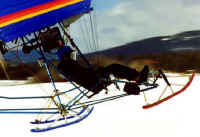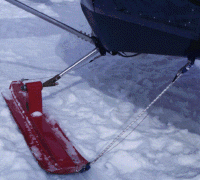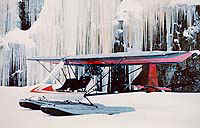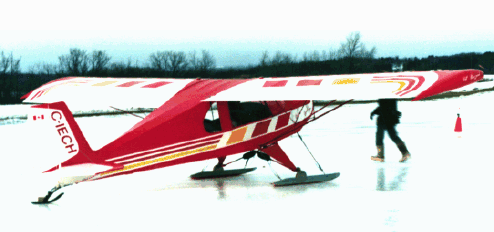|
There are several things that you have to take into consideration:

1. The length and width of the ski - with reference to the ultralight's
weight, take-off and landing speeds.
2. The type of material used to make and support the ski.
3. How the ski is supported at the axle, and at the front and back of the
ski.
Lets take a
look at these:
1. The length and width of the ski - will have to reflect the type
of surface you will be flying from. Deep, soft snow will require a
wider ski - while you will find longer narrower skis work better on harder
snow packed runways. On Quicksilver MX/Beaver/Challenger/Tundra/Kolb
aircraft with about an 800 lbs gross - my experience has shown that a ski
about 4 feet and 10 inches wide works well.
On aircraft such as the L'il
Buzzard/Kitfox/Avid etc - aircraft with a gross weight of 800-1200 lbs. a
ski 5 to 6 feet long and a foot wide is preferable - wider in snowier
areas. It should be noted that the nose ski can pose a problem for
aircraft with steerable nose wheels.
The ski puts a lot more load on the
supporting structure than a wheel does. On my first landing with the
Challenger I sheared the nose assembly off. Of course in tail draggers you
only use two mains and the tail ski is considerably smaller.
2.The Type of material used:
The first set of ski's I made, for my
Quicksilver MX - I made using water skis, while these worked well
initially, they were not strong enough for landings on rough surfaces.
The
ski broke on contact with a bump in the runway at about 17 mph and
shattered. I made another set up and re-enforced the bottoms with
fiberglass, they survived but during a crosswind landing the tower
supporting the ski broke due to the side load.
The next set I tried I made
out of fibreglass in a mold. They worked well on my Challenger but wore
the bottoms off after a season of flying. But those were the early days
their are now manufacturers producing skis that have all the bugs worked
out.
A survey of the industry shows that skis are now made from composite,
such as the ones we offer. Other manufacturers welded up a chromoly frame
in the shape of a ski and then cover it in plastic. Others use all
aluminum parts.
When considering skis consider the type of aircraft,
runway, and speed. *Check for a sturdy mount going from the aircraft to
the ski.
Remember that ski will have to take a side load at speeds in the
55 mph hour range in most applications.
*Check for some kind of a
replaceable wear bar - this will also act as a runner for steering on ice.
3. How the ski is supported at the axle, front and back. During
flight the ski has to have support at the axle, and at the front and back.
The axle support has to allow the ski to pivot, and most be able to take
enormous side loads.
Remember the ski contact area is more than 100 times
the wheel area. When the ski is in flight it must be supported at the
front so that it is always in a slight upward angle. If it is facing down
it could cause loss of control during flight due to the extra drag, and
could cause the ski to dig into the snow on landing.
To accomplish this
two bungee cords are required one on the front of the ski the other at the
rear. The tension should be enough that if you were
to lift the plane on that side on the ground the ski comes up at the
front. You will also need steel cables to act as limiter straps.
The front
strap will be loose while the bungee is under tension but if the bungee
were to fail t
|

RX 550 Beaver on Full Lotus Floats |
| Some pilots fly on Full Lotus floats during the winter, using the floats as ski's. Make sure to FIRST drain the float bladders of water - I have drained over 70 lbs. of water from the bladders after a summers worth of flying! |
hen the limiter strap will only allow the ski to come to a
neutral position. The rear bungee has to be loose enough to allow the
front of the ski to move up and down on rough fields - with the limiter
strap preventing it from coming up to far.
Both limiter straps and bungees
should be perpendicular to the ski and pulling upwards I have found 1/2
and 3/4 inch bungee to work great and can be purchased by the foot in
Canada ,at a local Canadian Tire store. Some pilots have just used the
standard bungee cord that comes with the hooks on the end.
On the L'il
Buzzard we attach a steel tang to the front lower motor mount. We then
attach one of those screw on clevis's - the kind that is rectangular in
shape that unscrews in the middle . By using this we
can leave the tang on the plane and use the clevis as a quick disconnect.
So
lets just do a quick review: - make sure you have a good
ski support -make sure that you have your bungee 's with the correct
amount of pressure -make sure that you have a set of safety cables front
and back installed at the correct length. -look carefully at the nose gear
in a trike configuration to see if it is capable of withstanding the types
of side loads you will be placing on it. -on icy surfaces make sure that
you have some kind of a steel runner to aid in steering.
One word of
caution Remember your skis do not have brakes and you have NO way of
slowing down or stopping other than colliding with something. Which of
course was the first lesson I learned on my first flight on skis.
U.B. Judge
Building a set of
"ultralight Ski's"
Ultralight
Ski's - amphib and regular.
|





